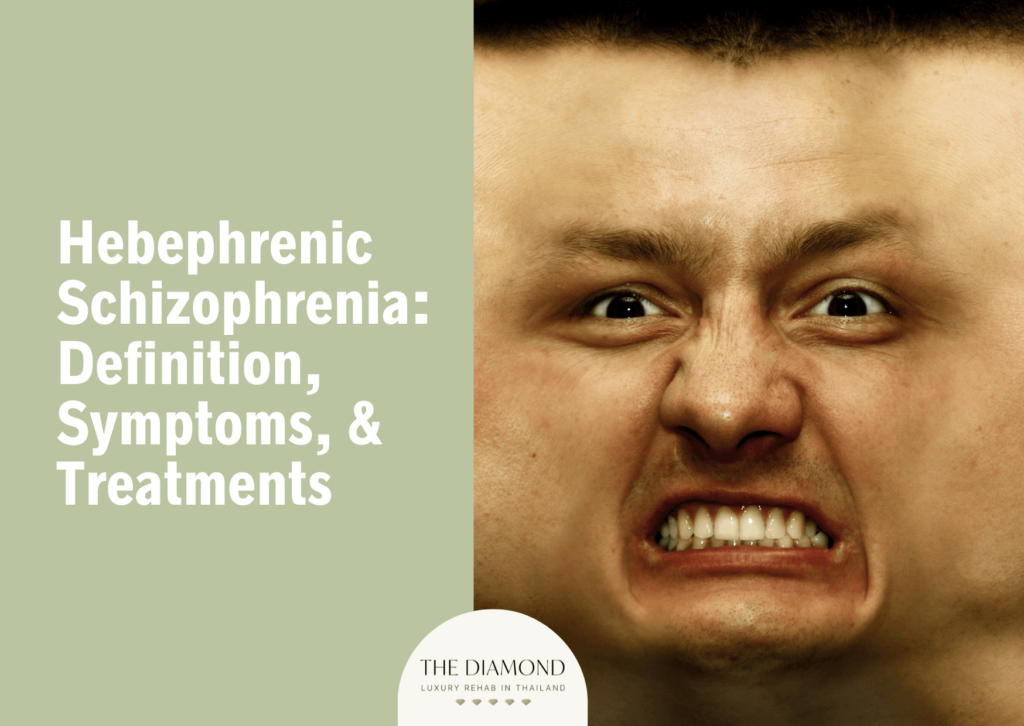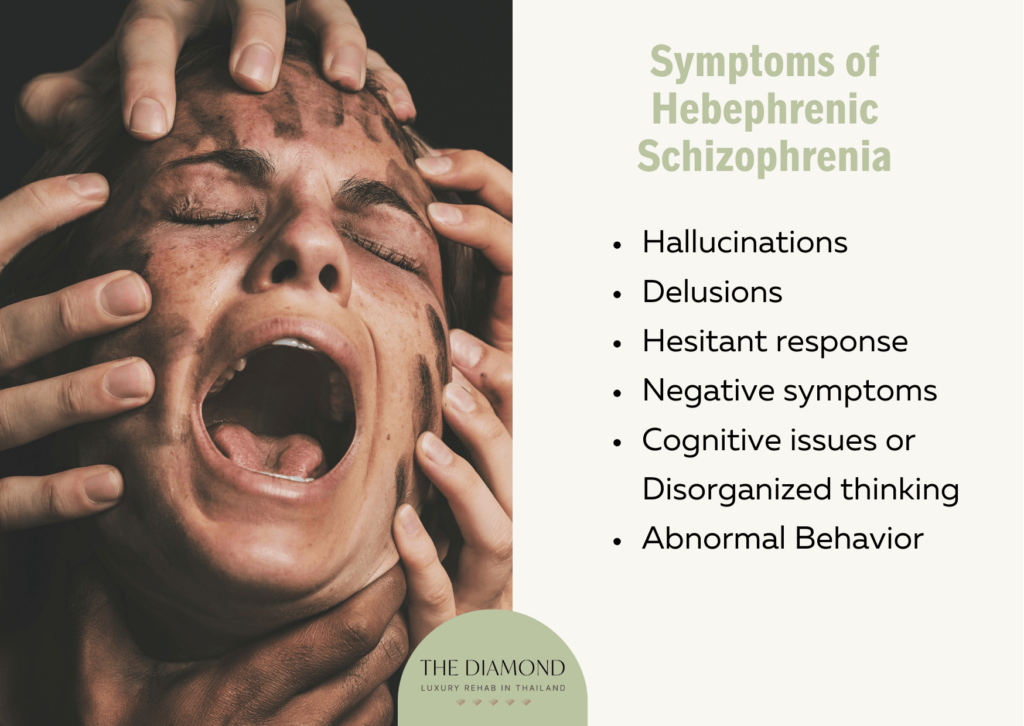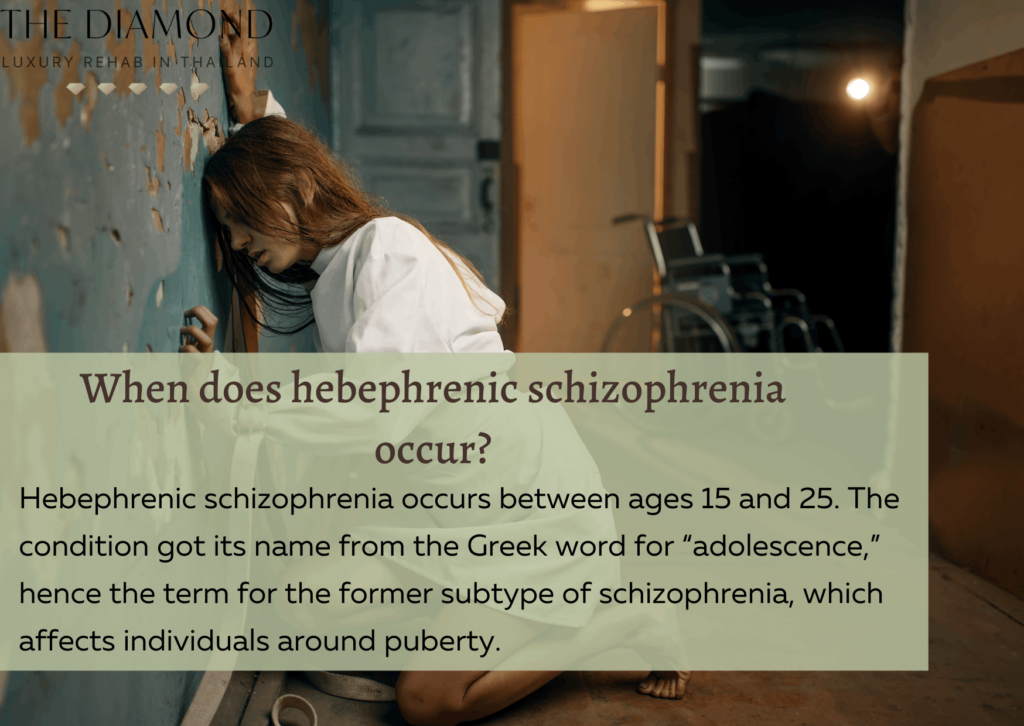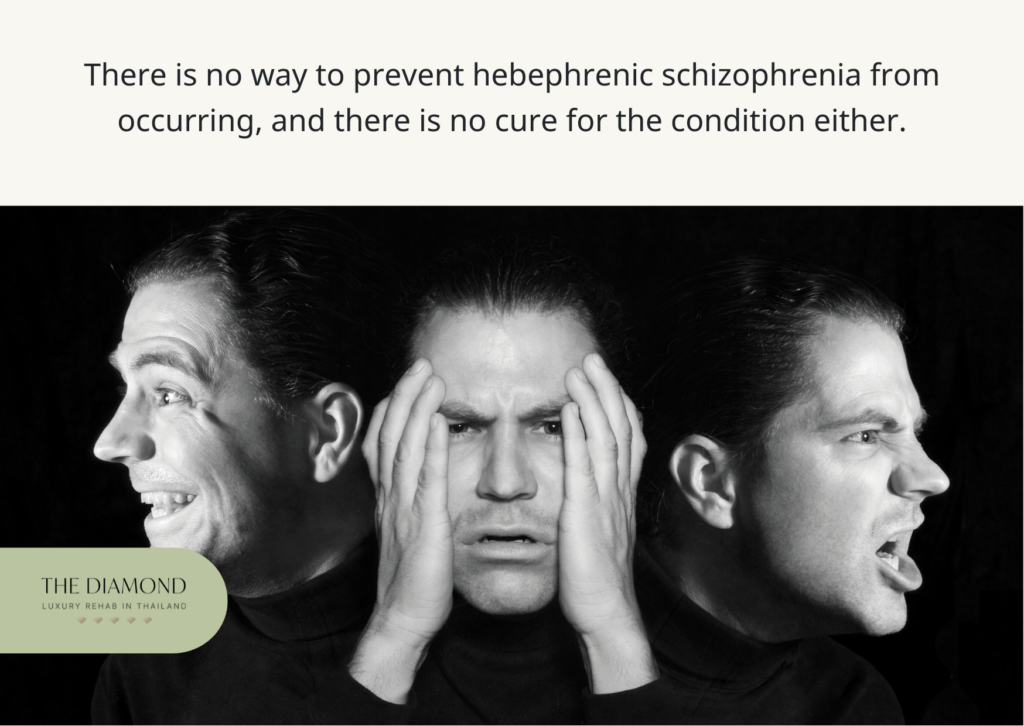Hebephrenic Schizophrenia: definition, symptoms, and treatments

Hebephrenic schizophrenia was once considered to be a subtype of schizophrenia that is sometimes referred to as disorganized schizophrenia. It is characterized by disorganized speech and illogical thought processes and behaviors.
Although it is no longer recognized in the Diagnostic and Statistical Manual of Mental Disorders (DSM-5) as a diagnosable condition, the term hebephrenic schizophrenia is still used to describe a group of symptoms, as stated by Healthline.
Hebephrenic schizophrenia symptoms include hallucinations, delusions, hesitant response, negative symptoms, cognitive issues or disorganized thinking, and abnormal behavior.
The possible treatments for hebephrenic schizophrenia are a combination of psychotherapy and medications.
What is hebephrenic schizophrenia?
Hebephrenic schizophrenia is a mental health disorder that involves unpredictable or inappropriate emotional responses, childish mannerisms, and bizarre behaviors. The condition is also called hebephrenia, which came from the Greek word for “adolescence.” This indicates the onset of schizophrenia hebephrenic symptoms around puberty, or in individuals between ages 15 and 25.
When updating to the fifth and latest edition, the DSM-5 no longer uses separate diagnostic categories schizophrenia, and instead recognizes it as a single condition. Today, however, the different subtypes are sometimes still used to identify elements of a schizophrenia diagnosis.
How common is hebephrenic schizophrenia?
The onset of schizophrenia in children below 13 is extremely rare, let alone hebephrenic schizophrenia. A case report published in The American Journal of Psychiatry estimates very early-onset schizophrenia to be in 1 in every 30,000 children.
Schizophrenia can also be hard to identify in teenagers. This is because early signs may easily be mistaken as a normal part of puberty. Moreover, in 80% of diagnosed cases, teenagers experience auditory hallucinations and do not have delusions or formal thought disorders until mid-adolescence, as stated by the non-profit organization The Whole Child.
According to a 2016 study published in the Journal of Translational Neuroscience (Beijing), while several studies demonstrate the equal prevalence of schizophrenia among men and women, most of those studies found that the onset of the condition occurs earlier in men (21 to 25 years old) than in women (25 to 30 and 45 years old).
A study published in the journal Dialogues in Clinical Neuroscience stated that late-life schizophrenia, or the onset of schizophrenia symptoms after the age of 44, makes up 15% to 20% of all cases of schizophrenia. Furthermore, according to the same study, onset after age 65 is indicative of very late-onset schizophrenia-like psychosis, which is usually secondary to medical conditions, such as dementia or other neurodegenerative disorders.
An online article published by the Cambridge University Press stated that the World Health Organization’s Ten Country Study found that hebephrenic behavior in schizophrenia was present in 13% of cases of schizophrenia in developed countries and 4% of schizophrenia cases in developing countries.
What are the causes of hebephrenic schizophrenia?
There is no single cause of schizophrenia. It is widely believed that a complex interplay of factors is involved in the development of the disorder. The causes of hebephrenic schizophrenia are listed below.
- Genetics: Although to this day, no specific gene has been identified as the cause of schizophrenia, experts believe that genetics may play a role in the development of the condition. Kendler et. al. (1998) reported that relatives of individuals with hebephrenia-like presentations had a dramatically increased risk of schizophrenia, compared with relatives of those with other schizophrenia presentations.
- Changes in brain structure: Current magnetic resonance imaging (MRI) technology has allowed experts to observe the brain in real time. Structural brain changes that have been observed in those with schizophrenia include reduced gray and white matter, temporal lobe volume reductions, and ventricular enlargement.
- Co-occurring mental health conditions: Living with other mental health issues, such as anxiety, depression, or dissociative disorders, may increase your chances of developing schizophrenia. Conversely, having schizophrenia may also result in developing symptoms of other mental health conditions.
- Environmental factors: Several environmental factors have been associated with an increased risk of developing schizophrenia, including childhood trauma, social isolation, early and late first birth in women, birth and pregnancy complications, and urban upbringing. Although these factors do not directly cause schizophrenia, they may interact with other possible causes and increase your chances of developing the disorder.
What are the symptoms of hebephrenic schizophrenia?

Hebephrenic schizophrenia is mainly characterized by a lack of harmony between a person’s gestures, emotions, and the content of their statements. The symptoms of hebephrenic schizophrenia are listed below.
1. Hallucinations
Hallucinations are sensory experiences that may appear real but only exist in the mind. They can be in any of the senses, such as hearing sounds or voices no one else hears, seeing things that don’t exist, smelling things that seem real but are not, or feeling of insects crawling underneath the skin. These hallucinations tend to be more vivid in people with schizophrenia. The physical effects of hallucinations include accidental injuries, intentional harm to oneself, visual or hearing problems, headaches, and seizures. Hallucinations may also have behavioral effects, including paranoid or aggressive behavior, difficulty trusting people, and suicidal behaviors.
2. Delusions
Delusions are firmly-held beliefs that remain unchanged despite clear, reasonable evidence to the contrary. The physical effects of delusions include self-inflicted injuries, poor performance at work or school, and inability to care for self, while behavioral effects include relationship conflicts, social isolation, anger outbursts, depression, worsening of co-occurring mental health disorders, and legal issues as a result of acting on their delusions.
3. Hesitant response
One of the symptoms of hebephrenic schizophrenia is a hesitant response, which is defined as the inability to keep one’s thoughts straight and to express what’s in their mind through speaking and writing. The physical effects of a hesitant response include changes in movement, lack of facial expression, rapid and pressured speech, and even lack of speech. Its behavioral effects may also include irritability, poor judgment, paranoia, and wandering train of thought.
4. Negative symptoms
The negative symptoms of hebephrenic schizophrenia refer to the absence of something that significantly affects daily functioning, such as speech, motivation, or pleasure. The physical effects of experiencing those negative symptoms include difficulty eating, showering, or holding down a job due to a severe lack of motivation, diminished expression of emotion, lack of sexual desire, reduction of speech, and decreased use of body language. Behavioral effects of negative symptoms may include emotional flatness, lack of interest in leisure activities, and socialization difficulties.
5. Cognitive issues or Disorganized thinking
Cognitive issues or disorganized thinking are defined as disturbances in one’s structure or form of thinking that lead to abnormal ways of expressing spoken or written language. It is one of the defining features that may constitute what’s hebephrenic schizophrenia. The physical effects of disorganized thinking include disorganized speech, rapid shifting between topics that are unrelated, repetition of words or ideas over and over again, and using made-up words that can only be understood by the patient. On the other hand, the behavioral effects of disorganized thinking include extreme irritability, depression, poor judgment, disjointed thinking, and paranoia.
6. Abnormal Behavior
Abnormal behavior means the behavior is not focused on a goal, which means it’s difficult to do tasks, according to Mayo Clinic. Disorganized or abnormal motor behavior has been linked to poor functional outcomes. The physical effects of abnormal behavior in people with hebephrenic schizophrenia are poor hygiene, difficulty getting dressed, failure to do laundry or change clothes and an overall decline in daily functioning. The behavioral effects of abnormal behavior include childlike or regressive behavior, inappropriate emotional responses, bizarre mannerisms, and useless and excessive movement.
What are the risk factors for hebephrenic schizophrenia?
Experts are not exactly sure what causes schizophrenia. However, there are certain factors that can increase one’s likelihood of developing the condition. The risk factors for hebephrenic schizophrenia are listed below.
- Substance use: Recreational use of drugs during adolescence has been implicated in the development of schizophrenia. The earlier the young individuals start using drugs and the more frequently they engage in drug abuse, the greater their chances of suffering from the condition. Conversely, according to Verywell Mind, substance use can also stem from schizophrenia.
- Being born to older fathers: According to research published in the medical journal JAMA Psychiatry, advanced paternal age is found to be a risk factor for schizophrenia and related disorders, mental retardation, and autism spectrum disorders.
- Maternal infection during pregnancy: Maternal viral infection during pregnancy has been considered a risk factor for schizophrenia. Fetuses who were exposed to viruses, such as influenza, measles, rubella, or polio during the first and second trimesters of their mother’s pregnancy were found to have an increased risk of developing schizophrenia later in life, as stated by a study published in the Journal of Psychiatry and Neuroscience. It is widely believed that these viruses can reach and directly affect the fetal brain and its development.
- Prenatal malnutrition: Exposure to prenatal malnutrition is strongly associated with an increased risk of schizophrenia in adulthood. Several studies that explored the Dutch and Chinese famines suggest that fetal exposure to malnutrition can lead to schizophrenia later in life.
How is hebephrenic schizophrenia diagnosed?
Hebephrenic schizophrenia is no longer recognized as a diagnosable condition by the DSM-5. That said, experts now consider schizophrenia a single condition and no longer use its subtypes in making a diagnosis. Still, the disorder may or may not present with hebephrenic schizophrenia symptoms.
To diagnose schizophrenia, a doctor or mental health professional may make use of a physical exam, screening tests, imaging studies, or a psychiatric assessment. A physical exam may be helpful in ruling out other physical health problems that could cause mental health symptoms.
Screening tests may also be done to identify alcohol or drug problems due to the fact that substance use disorders and psychological problems often co-occur. Additionally, a psychiatric assessment will be conducted to observe a patient’s mental state by asking about their thoughts, and feelings, as well as family and personal medical history to arrive at a diagnosis.
In making a diagnosis, a licensed therapist may use the diagnostic criteria for schizophrenia indicated in the DSM-5. To receive a schizophrenia diagnosis, a patient has to show at least two of the main symptoms of the condition, namely delusions, hallucinations, disorganized speech and behavior, catatonia, and negative symptoms, most of the time for a month.
When does hebephrenic schizophrenia occur?

Hebephrenic schizophrenia occurs between ages 15 and 25. The condition got its name from the Greek word for “adolescence,” hence the term for the former subtype of schizophrenia, which affects individuals around puberty.
The prominent features of the now-obsolete subcategory of schizophrenia are disorganized behavior and speech. People living with this condition are often unable to express their emotions in expected physical ways, which leads to a lack of emotion in their voices or facial expressions.
How does hebephrenic schizophrenia affect the body?
Hebephrenic schizophrenia affects the body in many ways, including causing changes in body language, emotions, and sleep patterns, poor grooming or hygiene, and reduced sex drive. In addition, people with schizophrenia are also more prone to physical illnesses compared to the general population.
According to a study published in the journal European Psychiatry, schizophrenia patients are at an increased risk of weight gain, diabetes, metabolic syndrome, abdominal obesity, and cardiovascular disease. These physical health problems also tend to occur at a younger age and can contribute to overall decreased quality of life.
How does hebephrenic schizophrenia affect the brain?
Hebephrenic schizophrenia affects the brain by causing an imbalance in brain chemicals that influence behavior, thoughts, and emotions, leading to a disturbance in emotional expression. According to WebMD, doctors also believe that the brain of schizophrenic patients loses tissue over time.
Furthermore, according to research published in the International Journal of Global Health and Health Disparities, the schizophrenic brain weighs five percent less than a normal brain, with the ventricles noticeably enlarged during autopsy.
What are the possible treatments for hebephrenic schizophrenia?
The possible treatments for hebephrenic schizophrenia are listed below:
1. Psychotherapy
Psychotherapy is a group of treatment techniques that help overcome psychological disorders through verbal interactions with a mental health professional. The most widely used type of psychotherapy for those with schizophrenia is cognitive behavioral therapy (CBT). CBT operates on the idea that negative thoughts and emotions contribute to problematic actions. Therefore, its goal is for the patient to unlearn these unhelpful thinking patterns and learn to adopt better-coping strategies. According to a 2021 study published in the Archives of Neuropsychiatry, CBT is particularly helpful in treating the positive symptoms of schizophrenia. These include delusions, hallucinations, and disorganized behavior, and speech.
2. Medications
Medications refer to substances used for the medical treatment of a wide range of conditions or illnesses. Antipsychotic drugs are the most commonly prescribed medications for schizophrenia. They are thought to work by reducing the effect of the neurotransmitter dopamine on the brain. Examples of hebephrenic behaviors that can be improved by medications are anxiety, aggression, hallucinations, and delusions.
How to prevent hebephrenic schizophrenia?

There is no way to prevent hebephrenic schizophrenia from occurring, and there is no cure for the condition either.
However, it is still possible for a person with schizophrenia to lead a happy and fulfilling life because symptoms can be made less severe with the help of professional treatment. A return of symptoms is highly likely during recovery, but this is where the importance of sticking to the treatment plan comes in. Schizophrenia is a long-term medical condition that requires lifelong treatment. Straying from the treatment plan may cause relapse and may lead to hospitalization.
What to expect in hebephrenic schizophrenia condition?
One can expect to see significant changes in the behavior and speech of someone with hebephrenic schizophrenia. The condition is also referred to as disorganized schizophrenia, owing to the fact that its key features are disorganized behavior and speech, which means these actions in people with the disorder tend to be self-contradictory or inconsistent.
As a result, individuals with hebephrenic type schizophrenia may display inappropriate behavior, gestures, or actions. They may also have problems with concentration and with expressing thoughts, which can show in the way they speak.
What is the difference between hebephrenic schizophrenia and catatonic schizophrenia?
The difference between hebephrenic schizophrenia and catatonic schizophrenia is their prominent characteristics. While hebephrenic schizophrenia is characterized by disorganized behavior and speech, the key features of catatonic schizophrenia are extreme changes in movement that may include either an inability to move or hyperactivity.
Although symptoms such as delusions and hallucinations may also occur, they may be less pronounced in people with hebephrenic schizophrenia. On the other hand, according to a study published in The Journal of Neuropsychiatry and Clinical Neurosciences, patients with catatonia often present with delusional preoccupations.

